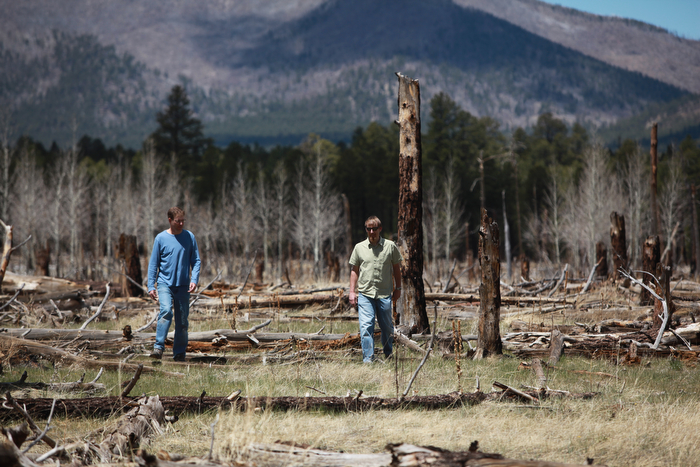Crown Fires and Greenhouse Gases
Large, unnatural crown fires making headlines are upsetting the carbon balance, both while they are burning and for years to come. This, scientists say, is contributing to global warming. While we all know trees breathe in carbon dioxide, how long they can hold onto it affects the amount of greenhouse gases in the atmosphere. Charred logs, standing dead tree trunks and decaying branches mark the site of the 1996 Hochderffer fire, a crown fire that burned 16,000 acres west of the San Francisco Peaks. Forest ecologist Mike Stoddard with the Ecological Restoration Institute at Northern Arizona University has been looking for a sign, any sign, of ponderosa pine seedlings 15 years after the fire. "These large fires are devastating our forests," said Stoddard. "We're concerned that ponderosa pine is not regenerating after these wildfire events." Scientists also are concerned about the invisible impacts of these fires that burn through the treetops. Forest ecologist Dr. Matthew Hurteau with NAU's School of Earth Sciences and Environmental Sustainability says there are two types of emissions associated with wildfire. "Direct emissions happen when fire burns up the biomass or plant material like pine needles on the trees. Then there are indirect emissions. Over time, the stuff that's left in the woods, the dead decomposing trees, is emitting carbon dioxide into the atmosphere." In research conducted from 2001 to 2007, Hurteau says wildfire emissions in the United States were equivalent to 4 to 6 percent of all our nation's emissions from burning coal, oil and natural gas. The percentage of lingering indirect emissions is even greater. "We're looking to forests to take in carbon, thereby lowering the greenhouse gases. But at a site like the Hochderffer fire, the grassy vegetation that's growing in is not making up for the amount of carbon that's being released from the dead trees." DIFFERENT SITE, SAME STORY Across Highway 180, the story is much the same. NAU School of Forestry professor and tree physiologist Dr. Tom Kolb is calculating the amount of carbon dioxide moving between the land and the air at the site of the Horseshoe Fire. This 8,000-acre crown fire also burned in 1996. Above the rotting logs, carbon dioxide is flowing through claw-like fingers of a device called an eddy covariance system. Funded by a U.S. Department of Agriculture National Research Initiative grant, Kolb is measuring gases being released from deforested and forested sites. "The fire has had a long-term legacy effect on the capacity of this site to take in and store carbon dioxide. Prior to the fire, this was a dense forest that would take in somewhere between 100 and 200 grams of carbon per square meter per year. Now it's actually releasing carbon dioxide into the atmosphere at a rate of 50 to 100 grams of carbon per square meter per year. That release is greater than the uptake via photosynthesis by the sparse coverage of grasses and shrubs that came in after the fire. This site has gone from being a carbon sink, where carbon was being stored, to a carbon source, where carbon is being released." Burnt remains of intense fires dot Southwestern ponderosa pine forests. Forest Service silviculturist David Lawrence walks through the decomposing wood of the Cerro Grande fire that burned 48,000 acres 11 years ago near Santa Fe, N.M. "The changes have been noticeable and measurable over time regarding the fire length and severity," said Lawrence. "Since settlement times, with livestock grazing and fire suppression, the forests have gotten much denser and the fire behavior is much different than it used to be. It may be a...
Read More
